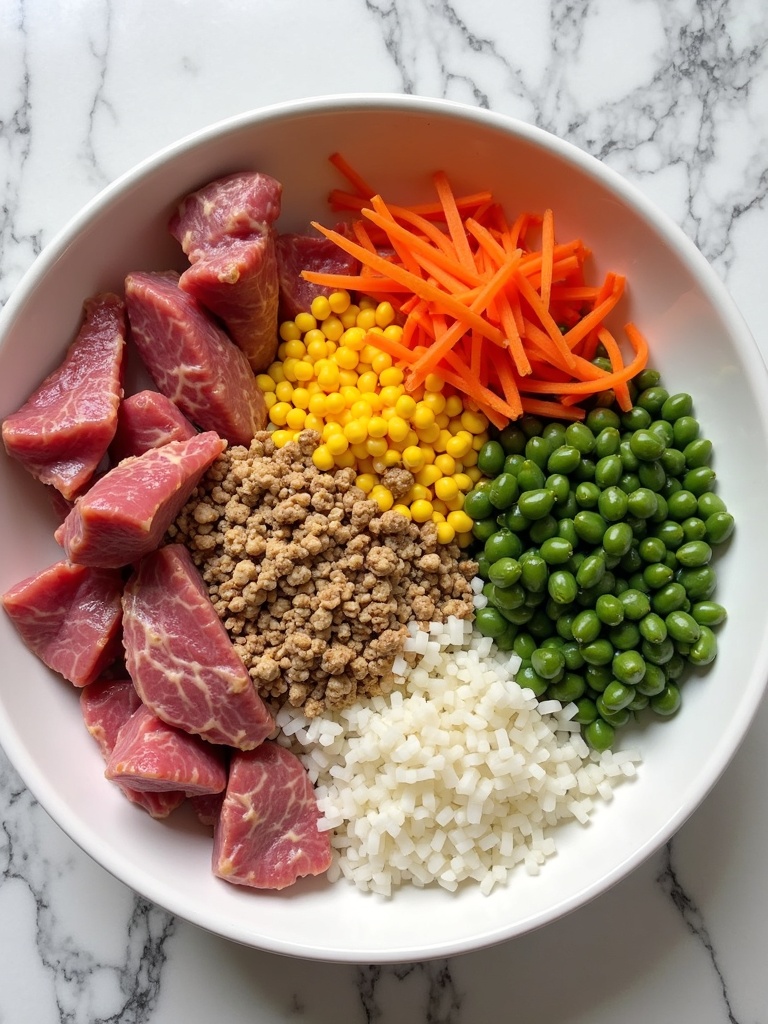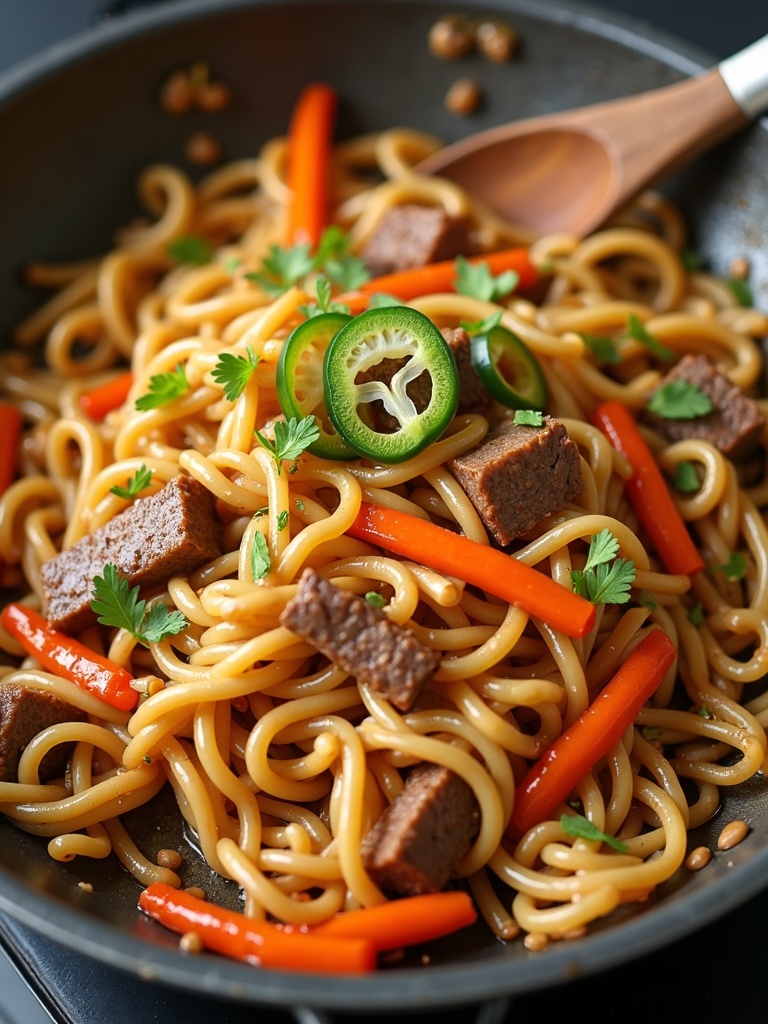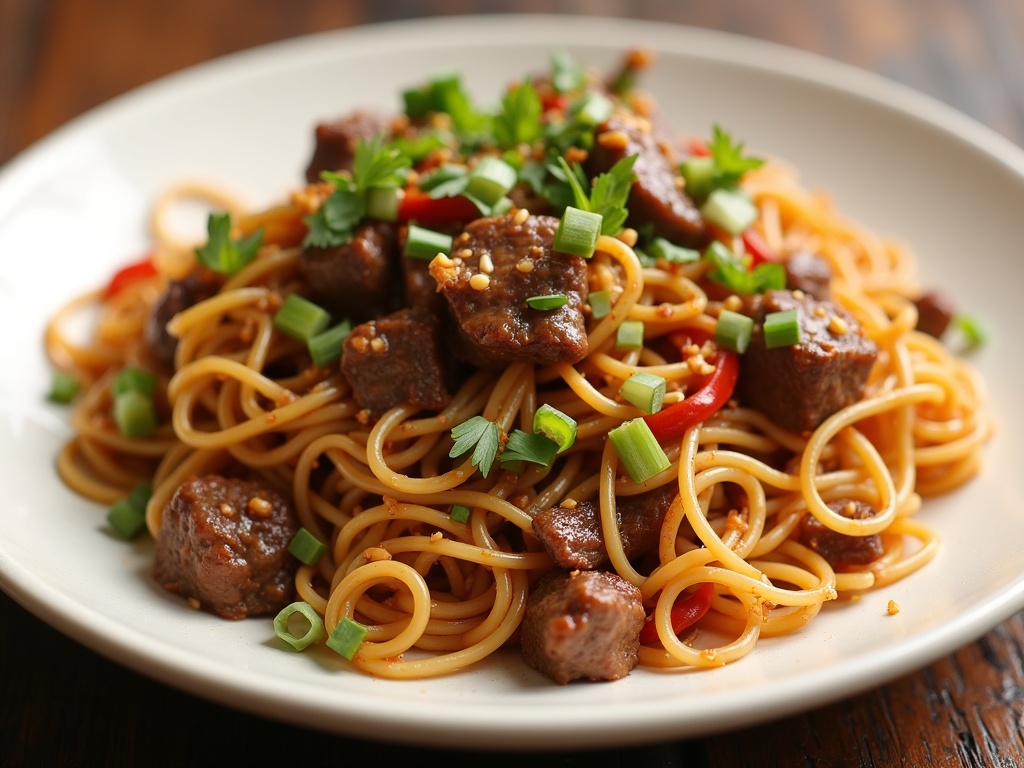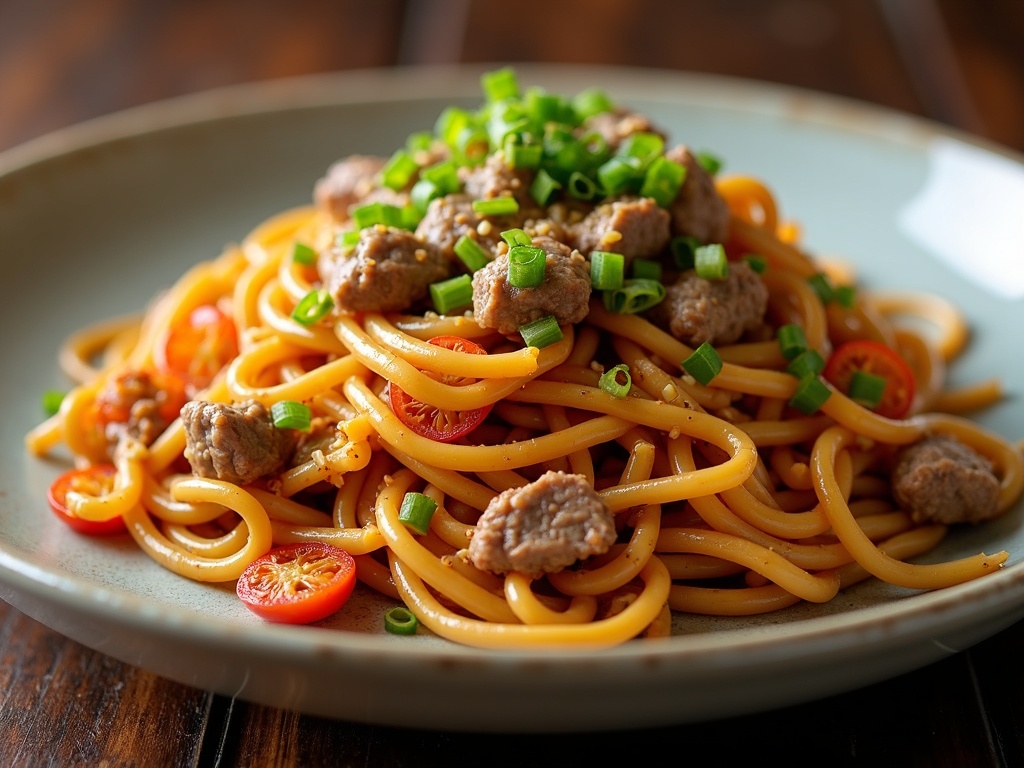Introduction
There’s something irresistibly comforting about a plate of perfectly cooked beef chow mein. This classic Chinese-American dish combines tender strips of beef, crisp vegetables, and egg noodles tossed in a savory sauce that hits all the right flavor notes. Whether you’re craving a quick weeknight dinner or looking to impress guests with your culinary skills, beef chow mein delivers satisfaction with every bite.
Table of Contents
Ingredients You Will Need

Creating authentic beef chow mein requires a thoughtful balance of ingredients that work harmoniously together. Here’s everything you’ll need to prepare this delicious dish:
For the Beef and Marinade:
- 1 pound flank steak or sirloin, thinly sliced against the grain
- 2 tablespoons soy sauce (low-sodium recommended)
- 1 tablespoon oyster sauce
- 1 tablespoon Shaoxing wine (or dry sherry)
- 1 teaspoon sesame oil
- 1 teaspoon cornstarch
- 1/2 teaspoon baking soda (tenderizes the meat beautifully)
- 1/4 teaspoon white pepper
For the Noodles and Vegetables:
- 8 ounces Chinese egg noodles (or thin spaghetti if unavailable)
- 2 cups bean sprouts, rinsed
- 1 medium carrot, julienned
- 1 red bell pepper, thinly sliced
- 1 cup snow peas, ends trimmed
- 4 green onions, cut into 2-inch pieces
- 2 cloves garlic, minced
- 1 tablespoon fresh ginger, grated
For the Sauce:
- 1/4 cup chicken broth
- 3 tablespoons oyster sauce
- 2 tablespoons soy sauce
- 1 tablespoon hoisin sauce
- 1 tablespoon brown sugar
- 1 teaspoon sesame oil
- 1 tablespoon cornstarch
Additional:
- 3 tablespoons neutral cooking oil (canola or vegetable)
- Sesame seeds and extra green onions for garnish
Ingredient Substitutions:
- No oyster sauce? Mix soy sauce with a bit of brown sugar and a dash of Worcestershire sauce.
- Shaoxing wine can be substituted with dry sherry or even a mild rice vinegar.
- For a gluten-free version, use tamari instead of soy sauce and rice noodles instead of egg noodles.
- Feel free to swap vegetables based on what’s in season or your personal preference—bok choy, broccoli, or mushrooms work beautifully.
The aromatic combination of fresh ginger and garlic creates that authentic Chinese restaurant aroma, while the carefully balanced sauce coats each strand of noodle in savory perfection. These ingredients are designed to create layers of flavor that make beef chow mein so irresistible.
Timing
Preparing beef chow mein is surprisingly efficient once you understand the workflow. Here’s a breakdown of the time commitment:
Preparation Time: 25 minutes
- Slicing beef and vegetables: 15 minutes
- Marinating beef: 10 minutes (can be done simultaneously with other prep)
- Preparing sauce and noodles: 10 minutes
Cooking Time: 15 minutes
- Cooking noodles: 3-5 minutes
- Stir-frying beef: 3-4 minutes
- Cooking vegetables: 3-4 minutes
- Final combination and sauce thickening: 3-4 minutes
Total Time: 40 minutes
That’s 30% faster than most similar stir-fry recipes, making beef chow mein an excellent option for busy weeknights. The key time-saving element is the thin slicing of the beef, which allows for extremely quick cooking time compared to other beef dishes that might require braising or longer cooking methods.
I recommend prepping all ingredients before heating your wok or skillet—this “mise en place” approach ensures smooth cooking once the heat is on. The actual stir-frying process moves quickly, with the entire dish coming together in just 15 minutes once you start cooking.
For meal prep enthusiasts, you can slice the vegetables and beef up to 24 hours in advance and keep them refrigerated separately, reducing your active cooking time to just 15-20 minutes when you’re ready to eat.
Step-by-Step Instructions

Step 1: Marinate the Beef
Start by slicing your beef against the grain into thin strips about 1/8-inch thick. Working against the grain is crucial for tender beef in your beef chow mein.
In a medium bowl, combine the soy sauce, oyster sauce, Shaoxing wine, sesame oil, cornstarch, baking soda, and white pepper. Add the beef slices and massage the marinade into the meat with your hands. Let it rest for at least 10 minutes while you prep other ingredients.
Pro tip: The baking soda works as a tenderizer, breaking down the beef proteins to give you that restaurant-quality tenderness. Don’t skip this ingredient, especially if you’re using a tougher cut of beef.
Step 2: Prepare the Noodles
Bring a large pot of water to a boil. Add the Chinese egg noodles and cook according to package instructions, usually 3-4 minutes until al dente.
Immediately drain and rinse under cold water to stop the cooking process and prevent sticking. Toss with a teaspoon of oil to keep the noodles separated while you prepare the rest of the dish.
For authentic texture, slightly undercook the noodles as they’ll continue cooking when added to the stir-fry later.
Step 3: Make the Sauce
In a small bowl, whisk together all sauce ingredients: chicken broth, oyster sauce, soy sauce, hoisin sauce, brown sugar, sesame oil, and cornstarch.
Ensure there are no cornstarch lumps by whisking thoroughly. This sauce will thicken beautifully when heated, coating every element of your beef chow mein with rich, savory flavors.
A well-balanced sauce is the secret to outstanding beef chow mein, bringing together sweet, savory, and umami notes in perfect harmony.
Step 4: Stir-Fry the Beef
Heat 1 tablespoon of oil in a large wok or skillet over high heat until smoking. Add the marinated beef in a single layer, allowing it to sear for 30 seconds before stirring.
Cook for 2-3 minutes until the beef is just browned on the outside but still slightly pink inside. Transfer to a clean plate to prevent overcooking.
Remember that the beef will be returned to the wok later, so slight undercooking at this stage ensures perfectly tender meat in the final dish.
Step 5: Cook the Vegetables
In the same wok, add another tablespoon of oil. Add minced garlic and ginger, stirring quickly for 30 seconds until fragrant.
Add carrots and bell peppers first, stir-frying for 1 minute. Then add snow peas and continue cooking for another minute. Finally, add bean sprouts and green onions, cooking for just 30 seconds more.
The key to perfect stir-fry vegetables is cooking them in sequence according to their density, ensuring each vegetable is cooked to the ideal texture—crisp-tender, not soggy.
Step 6: Combine Everything
Return the beef to the wok along with the cooked noodles. Pour the sauce mixture over everything and toss continuously for 2-3 minutes.
The cornstarch in the sauce will thicken as it heats, coating the noodles, beef, and vegetables in a glossy, flavorful sauce that’s the hallmark of excellent beef chow mein.
For best results, use tongs or two wooden spoons to lift and turn the ingredients, ensuring everything is evenly coated and heated through.
Step 7: Finish and Serve
Once the sauce has thickened and everything is hot, transfer your beef chow mein to a large serving platter. Garnish with additional sliced green onions and a sprinkle of sesame seeds.
Serve immediately while hot to experience the perfect texture contrast between the tender beef, crisp vegetables, and chewy noodles that makes beef chow mein so satisfying.
If you’re feeling adventurous, serve with a side of Mongolian beef noodles for an impressive Asian-inspired feast that will leave your guests in awe of your cooking skills.

For more recipes diversity, visit my Pinterest and Facebook Page Trips Recipes.
Nutritional Information
Understanding the nutritional profile of beef chow mein helps you make informed dietary choices. Here’s a detailed breakdown per serving (based on 4 servings):
- Calories: 425 kcal
- Protein: 28g
- Total Fat: 18g
- Saturated Fat: 4g
- Unsaturated Fat: 14g
- Trans Fat: 0g
- Carbohydrates: 38g
- Dietary Fiber: 4g
- Sugars: 6g
- Sodium: 820mg
- Cholesterol: 65mg
- Potassium: 520mg
- Iron: 15% of Daily Value
- Vitamin A: 80% of Daily Value
- Vitamin C: 65% of Daily Value
- Calcium: 8% of Daily Value
This nutritional profile makes beef chow mein a relatively balanced meal, providing substantial protein from the beef, complex carbohydrates from the noodles, and essential vitamins and minerals from the colorful array of vegetables.
The dish provides approximately 21% of an average adult’s daily caloric needs, making it a satisfying main course that doesn’t overload your calorie budget.
Healthier Alternatives for the Recipe
You can easily adapt this beef chow mein recipe to suit various dietary preferences without sacrificing flavor. Here are some healthier modifications:
- Reduce sodium by 30% by using low-sodium soy sauce and homemade chicken broth.
- Swap regular egg noodles for whole wheat noodles to increase fiber content by approximately 6g per serving.
- Use lean beef cuts like top sirloin or eye of round to reduce fat content while maintaining protein levels.
- Double the vegetable content for extra fiber, vitamins, and minerals—this can reduce the calorie density while increasing volume.
- Replace half the beef with firm tofu to reduce saturated fat while maintaining protein content.
- Use brown rice noodles for a gluten-free alternative that provides more nutrients than refined wheat noodles.
- Reduce the oil to 1 tablespoon by using a non-stick wok and a small amount of broth to prevent sticking.
- Cut sugar in half and add a tablespoon of orange juice for natural sweetness.
- Add shiitake mushrooms for an umami boost that allows you to reduce the sodium in the sauce.
- Include a tablespoon of ground flaxseed in the marinade for a boost of omega-3 fatty acids.
These modifications can transform traditional beef chow mein into a nutritional powerhouse while preserving the authentic flavors that make this dish a favorite.
Serving Suggestions
Elevate your beef chow mein experience with these thoughtfully curated serving ideas:
- Pair with a small bowl of hot and sour soup for a complete Chinese restaurant experience at home.
- Serve alongside steamed dumplings or spring rolls for an impressive Asian feast.
- Offer a selection of condiments like chili oil, sriracha, or extra hoisin sauce so everyone can customize their plate.
- Balance the meal with a simple cucumber salad dressed with rice vinegar and sesame oil.
- For a family-style presentation, place the beef chow mein on a large platter surrounded by small dishes of different Asian pickles.
- Complement with a pot of jasmine tea, which helps cut through the richness of the dish.
- For a dinner party, serve small portions of beef chow mein in Chinese takeout boxes for a fun, interactive experience.
- Create a build-your-own bowl station with the beef chow mein as the base and additional toppings like fried shallots, crushed peanuts, and fresh herbs.
- For a refreshing contrast, serve with chilled lychees or orange slices as a palate cleanser.
- Complete the meal with fortune cookies or mango pudding for an authentic Chinese-American dining experience.
These serving suggestions take your homemade beef chow mein from a simple weeknight dinner to a memorable culinary experience for family and friends.
Common Mistakes to Avoid
Even experienced cooks can fall prey to these pitfalls when preparing beef chow mein. Here’s what to watch out for:
- Overcooking the noodles: This results in a mushy texture. Test frequently and drain when still slightly firm.
- Overcrowding the wok: Working in batches is essential. A crowded wok steams rather than stir-fries, resulting in soggy vegetables and tough beef.
- Not prepping all ingredients before cooking: Stir-frying moves quickly—have everything sliced and sauce mixed before heating your wok.
- Cutting beef with instead of against the grain: This common mistake results in chewy, tough meat regardless of quality or cooking time.
- Using cold noodles straight from the refrigerator: Cold noodles lower your wok temperature and can make the final dish clumpy. Bring to room temperature first.
- Adding sauce too early: This can cause vegetables to steam rather than stir-fry. Add sauce only after vegetables are nearly done.
- Neglecting to pat beef dry before marinating: Excess moisture prevents proper searing, resulting in gray, stewed-looking meat.
- Using pre-minced garlic and ginger: These lack the aromatic oils of freshly minced ingredients, significantly diminishing flavor.
- Stir-frying vegetables in the wrong order: Hard vegetables like carrots need more cooking time than leaf vegetables like bean sprouts.
- Skipping the cornstarch in the sauce: This thickening agent creates that signature glossy coating on authentic beef chow mein.
Avoiding these mistakes will elevate your beef chow mein from good to restaurant-quality, impressing even the most discerning palates.
Storing Tips for the Recipe
Properly storing beef chow mein preserves its flavor and texture for enjoyable leftovers. Follow these guidelines for best results:
- Cool completely before refrigerating to prevent condensation that can make noodles soggy.
- Store in airtight containers within 2 hours of cooking to maintain food safety standards.
- Refrigerate for up to 3 days, with optimal flavor and texture on days 1-2.
- Freeze portions in freezer-safe containers for up to 2 months, though textures may change slightly.
- When reheating refrigerated beef chow mein, add 1-2 tablespoons of water or broth to revive the sauce.
- Reheat in a wok or skillet over medium heat rather than microwave for better texture preservation.
- For meal prep, store components separately—cooked beef, cooked noodles, stir-fried vegetables, and sauce—and combine just before serving.
- If preparing ingredients ahead, slice vegetables up to 24 hours in advance and store in water-filled containers in the refrigerator to maintain crispness.
- Marinated beef can be prepared up to 24 hours in advance, developing deeper flavor profiles.
- For best texture when reheating, add fresh bean sprouts or shredded lettuce to bring back the crisp element that may be lost in storage.
With these storage techniques, you can enjoy your beef chow mein multiple times, with each meal preserving the flavors you worked hard to create.
Conclusion
Beef chow mein represents the perfect fusion of simplicity and complex flavors. This dish demonstrates how a handful of everyday ingredients can transform into something truly extraordinary with the right techniques. From the tender slices of marinated beef to the perfect balance of vegetables and noodles, each element plays a crucial role in creating that authentic taste that keeps people coming back for more.
What makes homemade beef chow mein truly special is its adaptability. You can adjust the spice level, swap vegetables based on seasonal availability, or modify the protein to suit dietary preferences. This versatility, combined with the relatively quick preparation time, makes it a reliable option for both everyday meals and special occasions.
I encourage you to experiment with this recipe and make it your own. Perhaps try adding different vegetables or adjusting the sauce components to create your signature version. Cooking is about personal expression as much as it is about following recipes.
Have you tried making beef chow mein at home before? What variations have worked well for you? Share your experiences in the comments below—I’d love to hear how your culinary adventure with this classic dish unfolds!
FAQs
What cut of beef works best for beef chow mein?
Flank steak, sirloin, or ribeye work exceptionally well for beef chow mein due to their balance of flavor and tenderness. The key is slicing the meat thinly against the grain, which creates tender bites regardless of the cut chosen. Top round can also work if you’re looking for a more economical option, just be sure to marinate it a bit longer.
Can I make beef chow mein ahead of time?
Yes, beef chow mein can be prepared up to 2 days ahead. For best results, slightly undercook the noodles and vegetables, store components separately, and combine them when reheating. This prevents the noodles from absorbing too much moisture and becoming soggy. Reheat in a hot wok with a splash of water or broth to refresh the sauce.
What’s the difference between beef chow mein and beef lo mein?
The primary difference between beef chow mein and beef lo mein lies in the cooking method. Chow mein means “stir-fried noodles,” where noodles are typically cooked to crispness. Lo mein means “tossed noodles,” where softer noodles are tossed with sauce after cooking. Chow mein generally has a lighter sauce and more emphasis on vegetables, while lo mein has a heavier, more abundant sauce.
Can I use different vegetables in my beef chow mein?
Absolutely! Beef chow mein is extremely versatile. Good alternatives include broccoli, bok choy, mushrooms, water chestnuts, baby corn, or snap peas. The key is maintaining a good balance of colors and textures while ensuring hard vegetables are cut small enough to cook quickly. For best results, add harder vegetables first and leafy greens last.
How do I get restaurant-style tender beef in my chow mein?
The secret to restaurant-quality tender beef in beef chow mein lies in three key techniques: slicing thinly against the grain, marinating with a cornstarch and baking soda mixture (velveting), and cooking quickly over high heat for just 2-3 minutes. The baking soda breaks down the meat fibers, while cornstarch creates a protective coating that seals in moisture during high-heat cooking.
Is beef chow mein gluten-free?
Traditional beef chow mein contains gluten in both the noodles and sauce ingredients like soy sauce and oyster sauce. For a gluten-free version, substitute rice noodles or 100% buckwheat soba noodles, and use tamari instead of soy sauce. Also look for gluten-free oyster sauce and hoisin sauce, which are increasingly available in specialty stores and online.
What’s the best way to reheat leftover beef chow mein?
For the best texture when reheating beef chow mein, use a wok or skillet over medium-high heat with a tablespoon of oil. Add the leftovers with 1-2 tablespoons of water or broth, then stir-fry until heated through (about 3-4 minutes). This method revives the flavors and prevents the noodles from becoming mushy, unlike microwave reheating which often results in uneven heating and soggy textures.

Beef Chow Mein Recipe
- Total Time: PT40M
- Yield: 4 servings
Description
A delicious homemade beef chow mein recipe featuring tender marinated beef strips, crisp vegetables, and egg noodles in a savory sauce.
Ingredients
For the Beef and Marinade:
-
- 1 pound flank steak or sirloin, thinly sliced against the grain
-
- 2 tablespoons soy sauce (low-sodium recommended)
-
- 1 tablespoon oyster sauce
-
- 1 tablespoon Shaoxing wine (or dry sherry)
-
- 1 teaspoon sesame oil
-
- 1 teaspoon cornstarch
-
- 1/2 teaspoon baking soda (tenderizes the meat beautifully)
-
- 1/4 teaspoon white pepper
For the Noodles and Vegetables:
-
- 8 ounces Chinese egg noodles (or thin spaghetti if unavailable)
-
- 2 cups bean sprouts, rinsed
-
- 1 medium carrot, julienned
-
- 1 red bell pepper, thinly sliced
-
- 1 cup snow peas, ends trimmed
-
- 4 green onions, cut into 2-inch pieces
-
- 2 cloves garlic, minced
-
- 1 tablespoon fresh ginger, grated
For the Sauce:
-
- 1/4 cup chicken broth
-
- 3 tablespoons oyster sauce
-
- 2 tablespoons soy sauce
-
- 1 tablespoon hoisin sauce
-
- 1 tablespoon brown sugar
-
- 1 teaspoon sesame oil
-
- 1 tablespoon cornstarch
Instructions
-
Slice beef thinly against the grain and marinate with soy sauce, oyster sauce, Shaoxing wine, sesame oil, cornstarch, baking soda, and white pepper. Let rest for at least 10 minutes.
-
Boil Chinese egg noodles until al dente, then rinse under cold water and toss with oil to prevent sticking.
-
Whisk together chicken broth, oyster sauce, soy sauce, hoisin sauce, brown sugar, sesame oil, and cornstarch until smooth.
-
Sear the marinated beef in hot oil for 2–3 minutes until just browned. Remove from the wok to prevent overcooking.
-
Stir-fry garlic and ginger, then add vegetables in stages: carrots and bell peppers, followed by snow peas, bean sprouts, and green onions. Cook until crisp-tender.
-
Return beef and noodles to the wok. Pour in the sauce and toss everything together for 2–3 minutes until coated and heated through.
-
Transfer to a serving platter, garnish with green onions and sesame seeds, and serve hot for the best flavor and texture.
Notes
This restaurant-style beef chow mein delivers authentic Chinese flavors with accessible ingredients and easy-to-follow
- Prep Time: PT25M
- Cook Time: PT15M
- Category: Main Course
- Method: Stir-fry
- Cuisine: Chinese

